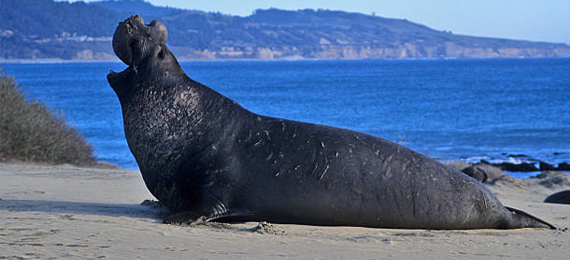
The Elephant Seals are rather large and earless aquatic animals in the genus Mirounga. In the 19th century, it was hunted for lamp oil and its breed was at risk of extinction, however, the counts increased later then. There are two species of elephant seals: the northern elephant seal ( Mirounga angustirostris)and the southern elephant seal (M. leonina). Additionally, they are the largest existing carnivoran weighing 5,000 kilograms.
Northern Elephant Seal
Northern elephant seals are found in California and Baja California, Mexico, and Alutein Islands often they prefer offshore places to the mainland. They are nonmigratory. Male Northern Elephant seal bulls can reach lengths of 4.3–4.8 m (14–16 ft) and a maximum weight of 4500 pounds. The female Elephant seals are comparatively smaller and grow about 10 ft long and weigh 1,300 pounds.
The northern elephant seal is the second-largest seal in the world.
Which genus do elephant seals belong to?
- A. Mirounga
- B. Loxodonta
- C. Zalophus
- D. Enhydra lutris
Southern Elephant Seals
Southern Elephant seals inhabit South Georgia and Macquarie Islands. These regions feature extremely cold conditions. The southern elephant seals spend time in oceans and visit the shore
only to reproduce and moult the furs. Of all the seals Southern Elephant seals are the largest. Males can grow up to 20 feet long weighing 8,800 pounds.
Elephant Seal Adaptations
Elephant seals feature a large circular eye which enables them to see in low light conditions while diving.
Elephant seal blubber is a fatty tissue that helps them to stay warm in the cold sea. It functions as an insulator to keep the internal organs warm at below 40 Fahrenheit. Elephant seals metabolize their blubber fat while fasting.
To oxygenate the body’s tissues, oxygen stored in the blood is transmitted throughout the body. Elephant seal has abundant blood volume and oxygen-saving blood molecules (hemoglobin, and myoglobin) in their blood than any other mammals on the land. This enables them to hold their breath for up to 2 hours and swim far deep.
While diving the seal’s heart rate slows to reduce the blood flow to the body. This process is known as bradycardia.
Breeding and Conflicts
The breeding season starts in December when the male seals move towards land. To show their dominance over other males they engage in violent battles before the female approaches.
The elephant seal gathers nearly 40 to 50 harems of females which are rather smaller than the males.
Sometimes the battle culminates in a blood bath or aggressive stance, and violent roaring.
During the battle, they raise their trunk-like nose and create drum-like noises, which could be heard more than a mile away.
Every December, the females visit the shore, and nearly 3 to 4 days after arriving, they give birth to the pups which conceived during the mating season(1 year ago).
Given the fact that the pups wouldn’t survive if they were born at sea, they have a delayed gestation period of seven months. It will nurse the pup for almost a month, and the weight of the pup increases rapidly. Pups will gain weight from 75 at birth to 250-350 in a month.
During the birth, the pups will be extremely hungry and create bleating noises. Often the females aggressively shield the pups using deafening vocalization.
At the final stage of the nursing period, the pups will be abruptly weaned and left alone.